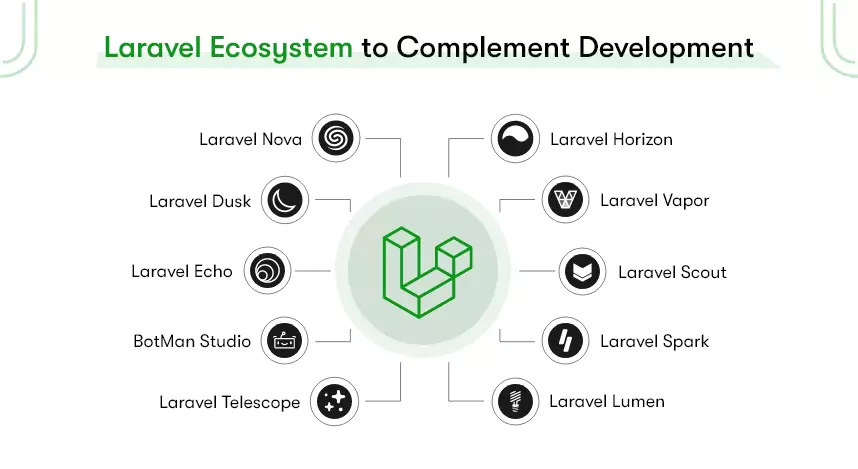In the ever-evolving landscape of web development, the synergy between a powerful backend and a nimble frontend is the cornerstone of a successful application. Laravel has long been celebrated for its elegant syntax, robust features, and developer-friendly ecosystem in the PHP world. On the frontend, a revolutionary approach has been gaining significant traction, a topic frequently buzzing in Svelte News. Svelte isn’t just another framework; it’s a compiler that shifts the bulk of the work from the browser to the build step, resulting in highly optimized, vanilla JavaScript and unparalleled performance.
Pairing Laravel’s backend prowess with Svelte’s surgical precision on the frontend creates a formidable full-stack solution. However, configuring these two distinct ecosystems to work seamlessly can be a complex task involving build tools, routing, and data-passing strategies. This is where starter kits enter the picture. These pre-configured project scaffolds provide the essential “glue,” allowing developers to bypass the tedious setup and dive straight into building features. This article offers a comprehensive guide to leveraging Laravel Svelte starter kits, exploring core concepts, implementation details, and advanced techniques to build modern, high-performance web applications.
Why Pair Laravel with Svelte? The Core Concepts
Before diving into the implementation, it’s crucial to understand the philosophies behind Laravel and Svelte and why their combination is so compelling. While many backend discussions in Node.js News revolve around frameworks like Express.js or NestJS, Laravel offers a uniquely integrated and mature ecosystem in the PHP space.
Laravel: The Backend Powerhouse
Laravel provides a solid foundation with an expressive and powerful feature set right out of the box. Key features include:
- Eloquent ORM: A beautiful, simple ActiveRecord implementation for working with your database. It makes database interactions intuitive and enjoyable.
- Robust Routing: A flexible and expressive routing engine that can handle everything from simple web pages to complex API endpoints.
- Built-in Authentication and Authorization: Laravel makes implementing secure authentication systems incredibly simple, saving developers countless hours.
- Vibrant Ecosystem: With tools like Forge, Vapor, and a massive library of community packages, Laravel’s ecosystem is second to none.
Svelte: The Compiler that Changes the Game
The world of frontend development is bustling, with constant updates in React News, Vue.js News, and Angular News. Svelte carves its own path by being a compiler. Instead of shipping a framework library to the browser to interpret your code at runtime (like React or Vue’s virtual DOM), Svelte compiles your components into highly efficient, imperative JavaScript that surgically updates the DOM. This leads to:
- No Virtual DOM: Svelte’s compiler approach eliminates the overhead of virtual DOM diffing, resulting in faster updates and a smaller memory footprint.
- Truly Reactive: Reactivity is a first-class citizen in Svelte. Simply assigning a new value to a variable is enough to trigger an update, leading to cleaner and more concise code.
- Smaller Bundles: Since there’s no framework runtime, the resulting JavaScript bundles are tiny, leading to faster load times and a better user experience.
This approach has inspired other frameworks, with developments in SolidJS News and Marko News also exploring compiler-centric innovations.
Here’s a look at the elegant simplicity of a Svelte component:
<script>
let count = 0;
function handleClick() {
count += 1;
}
</script>
<h1>Svelte Counter</h1>
<p>Current count: {count}</p>
<button on:click={handleClick}>
Click Me
</button>
<style>
button {
font-size: 1.2rem;
padding: 0.5em 1em;
border-radius: 8px;
cursor: pointer;
}
</style>From Zero to Hero: Implementing a Laravel Svelte Starter Kit
A good starter kit handles the complex configuration of the development environment, particularly the integration of a modern frontend build tool. The latest Vite News confirms its dominance as the go-to tool for modern JavaScript projects due to its incredible speed, and most Laravel starter kits leverage it by default. It replaces older, slower bundlers often discussed in Webpack News or Rollup News.

Installation and Project Structure
Getting started typically involves a single Composer command to create a new Laravel project with the Svelte preset. After installation, you’ll run `composer install` and `npm install` to pull in all PHP and Node dependencies.
Once installed, you’ll notice a few key areas in your project structure:
vite.config.js: The configuration file for Vite. The starter kit will have this pre-configured with the necessary plugins to handle Laravel and Svelte files.resources/js/: This is the heart of your Svelte application. It will typically contain subdirectories for components, pages (top-level components tied to routes), and layouts.routes/web.php: Your Laravel routes file. With a starter kit using a tool like Inertia.js, this file will define which Svelte page component to render for a given URL.
Your First Svelte-Powered Laravel Route
Many starter kits use Inertia.js to seamlessly connect the Laravel backend to the Svelte frontend without the complexity of building a full-blown API. Inertia allows you to make standard server-side routes that return JSON responses containing the component name and its data (props). The frontend then dynamically swaps out the page component.
Here’s how you would define a route in Laravel to render a Svelte page:
<?php
use Illuminate\Support\Facades\Route;
use Inertia\Inertia;
use App\Models\User;
/*
|--------------------------------------------------------------------------
| Web Routes
|--------------------------------------------------------------------------
*/
Route::get('/', function () {
return Inertia::render('Dashboard', [
'userCount' => User::count(),
'appName' => config('app.name'),
]);
});In this example, visiting the root URL (/) tells Inertia to render the Dashboard.svelte component located in resources/js/Pages/. It also passes two props, userCount and appName, directly from your PHP backend to your Svelte frontend.
The corresponding Svelte page component would receive these props like this:
<script>
// These props are passed directly from the Laravel controller
export let userCount;
export let appName;
</script>
<svelte:head>
<title>Dashboard - {appName}</title>
</svelte:head>
<div class="container">
<h1>Welcome to the {appName} Dashboard!</h1>
<p>We currently have <strong>{userCount}</strong> registered users.</p>
</div>
<style>
.container {
padding: 2rem;
text-align: center;
}
</style>Advanced Techniques: Building a CRUD Application
Let’s move beyond simple page rendering and build a dynamic feature: a task manager. This requires creating API endpoints in Laravel and building a Svelte component to interact with them for Create, Read, Update, and Delete (CRUD) operations.
Creating the Backend API
First, we’ll define a simple API route in routes/api.php and a corresponding controller method to fetch all tasks. While this example uses a simple API, more complex backends could be built with tools like AdonisJS or those from the Node.js ecosystem like Fastify News favorite, Fastify.
<?php
// In app/Http/Controllers/Api/TaskController.php
namespace App\Http\Controllers\Api;
use App\Http\Controllers\Controller;
use App\Models\Task;
use Illuminate\Http\Request;
class TaskController extends Controller
{
/**
* Display a listing of the resource.
*/
public function index()
{
// Return all tasks, ordered by creation date
return response()->json(Task::latest()->get());
}
/**
* Store a newly created resource in storage.
*/
public function store(Request $request)
{
$validated = $request->validate([
'title' => 'required|string|max:255',
]);
$task = Task::create($validated);
return response()->json($task, 201);
}
}State Management with Svelte Stores

For a feature like a task list, you’ll likely need to share the state (the list of tasks) across multiple components. Svelte provides a beautifully simple and powerful solution for this with its built-in stores. A store is simply an object with a `subscribe` method that allows interested parties to be notified whenever the store value changes.
We can create a `writable` store to hold our tasks. This is far simpler than the boilerplate often required by libraries discussed in React News or the older patterns from jQuery News.
// In resources/js/stores/taskStore.js
import { writable } from 'svelte/store';
// Create a writable store with an initial value of an empty array
export const tasks = writable([]);
// Function to fetch tasks from our Laravel API
export async function fetchTasks() {
try {
const response = await fetch('/api/tasks');
if (!response.ok) {
throw new Error('Failed to fetch tasks');
}
const data = await response.json();
tasks.set(data); // Update the store with the fetched tasks
} catch (error) {
console.error('Error fetching tasks:', error);
}
}
// Function to add a new task
export async function addTask(title) {
try {
const response = await fetch('/api/tasks', {
method: 'POST',
headers: {
'Content-Type': 'application/json',
'Accept': 'application/json',
},
body: JSON.stringify({ title }),
});
const newTask = await response.json();
// Add the new task to the existing list in the store
tasks.update(currentTasks => [newTask, ...currentTasks]);
} catch (error) {
console.error('Error adding task:', error);
}
}Now, any Svelte component can import and use this store. By prefixing the store name with a `$` sign in the component’s markup, Svelte will automatically subscribe and unsubscribe, making the component reactive to any changes in the task list.
Production-Ready: Best Practices and Optimization
Taking your application from development to production requires attention to code structure, testing, and performance.
Testing Your Full-Stack Application
A robust testing strategy is non-negotiable. For the Laravel backend, Pest and PHPUnit are the standards. For the Svelte frontend, the ecosystem is rich with options. Given our use of Vite, Vitest News reports it as a natural choice for unit and component testing due to its speed and compatibility. For end-to-end testing that simulates real user behavior, tools like Cypress News and Playwright News are excellent choices, allowing you to write tests that interact with both your compiled Svelte frontend and your live Laravel backend.
Code Quality and Tooling

Maintaining code quality across a project is essential. Integrating tools like ESLint and Prettier is a best practice. The latest ESLint News and Prettier News often highlight new rules and plugins that can enforce coding standards automatically. Furthermore, adopting TypeScript is highly recommended for larger projects. Staying current with TypeScript News will help you leverage its powerful type-checking capabilities to catch errors early. Modern starter kits often include configurations for these tools, along with faster transpilation tools like SWC, a topic frequently covered in SWC News as a Rust-based alternative to Babel.
Performance and Deployment
When you’re ready to deploy, you’ll run the `npm run build` command. Vite will then perform its magic: it will compile your Svelte components, bundle your JavaScript, process your CSS, and output highly optimized, production-ready static assets into the `public/build` directory. Laravel is already configured to automatically reference these versioned assets, ensuring your users always get the latest version without caching issues.
For further optimization, consider code-splitting your routes. This means JavaScript for a specific page is only loaded when the user visits that page, leading to smaller initial load times. Vite and Inertia.js can be configured to handle this automatically, ensuring your application remains fast and responsive as it grows.
Conclusion
The combination of Laravel and Svelte, streamlined by a well-crafted starter kit, represents a modern, powerful, and enjoyable way to build full-stack web applications. You get the stability, security, and comprehensive feature set of one of the world’s most popular backend frameworks, paired with a next-generation frontend compiler that delivers incredible performance and a delightful developer experience. By embracing this stack, you move away from the monolithic architectures of the past and into a world of reactive, component-based UIs powered by a robust backend.
The key takeaways are clear: Svelte’s compiler-first approach reduces bloat and increases speed, Laravel provides a world-class foundation for your business logic, and starter kits bridge the gap, eliminating configuration headaches. Your next step is to try it for yourself. Spin up a new project, explore the interaction between the backend and frontend, and start building the fast, modern web applications of the future.

